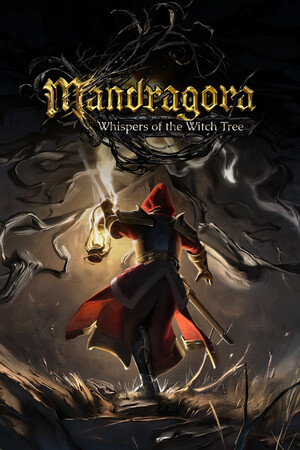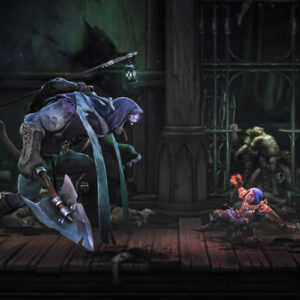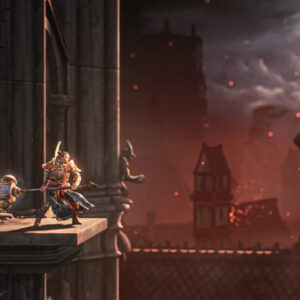Mandragora: Whispers of the Witch Tree Free Download Direct Steam-Cracked
Prologue: The Sorrowed Land
In the twilight-stained world of Faelduum, a withering hush settles upon the landscape like a veil of dust. Mountains sag under the weight of memory, rivers run sluggish and silver, and forests lean inward in mourning. All is still beneath the gnarled branches of the Witch Tree—a twisted monolith of grief and forgotten dreams. The people speak in hushed tones of the Dream-Echo, a second world born from the aching sorrow that drips from the Witch Tree’s roots. None remember when it began—only that it never ended.
Here, among roots that whisper in sleep and stars that flicker with prophecy, the player awakens. Not born, but remembered. A spirit whose name is a question, whose purpose is a puzzle. A soul plucked from the soil of regret, given form and breath by the Tree’s lament.
Gameplay Mechanics: Roots and Dreams
Mandragora is a narrative-rich action-RPG that fuses 2D exploration, dream-weaving, and dynamic storytelling. Players navigate both the waking world of Faelduum and the Dream-Echo—a shadowed mirror of reality where thought shapes matter and grief takes monstrous form. The central mechanic, Dream-Weaving, allows the player to reconstruct shattered memories to alter terrain, uncover secrets, and even influence characters’ emotions.
Combat is precise and punishing, with a stamina-based system. Weapons are relics imbued with emotions—blades of guilt, bows of longing, shields of denial. Each hit tells a story. But death is not the end: it is a passage deeper into the Dream-Echo. There, players encounter their shadow-selves—twisted reflections that remember choices the player didn’t make.
Setting: Faelduum and the Witch Tree
Faelduum is a land suspended in mourning. The Witch Tree stands at its center, roots spread through every corner of the realm. Entire villages have sunk into sleep, their inhabitants wandering the Dream-Echo unaware they ever lived. Time here has softened. Decades pass like minutes in some places; in others, a single hour stretches endlessly.
The Witch Tree is the heart of the world—a sentient, weeping entity said to have once been a woman. Some claim she was a god, others a queen who tried to preserve her kingdom by rooting herself into the world’s sorrow. Her branches cradle stars. Her roots dig through memory. Her fruit, known as Dream-Seeds, are objects of immense power that allow access to otherwise sealed parts of the Dream-Echo.
The Rootkin
Throughout Faelduum, the player encounters the Rootkin—plant-like creatures born from the Witch Tree’s dreaming sorrow. Some are benign, childlike things that mimic human behaviors. Others are tragic, fused amalgamations of people who refused to let go. Rootkin can be allies, enemies, or mournful observers. The player’s choices affect their growth. Feed them joy, and they bloom. Feed them anger, and they twist.
As Rootkin evolve through the player’s actions, they take on new forms:
- Caretenders: Gentle Rootkin that support nearby NPCs and restore areas of the Dream-Echo.
- Thornshades: Aggressive protectors that react to the emotional volatility of their environment.
- Bloombinders: Creators of bridges and paths between realms, shaped by the player’s empathy and insight.
Narrative Themes
- Grief as World-Building: Every location is a memory. Towns exist only because someone remembered them. A bridge is sturdy if someone still cares about the crossing. If a memory fades, so does the place.
- Unreliable Reality: The Dream-Echo is constantly shifting. Maps are suggestions. A place might change shape depending on what emotions the player brings.
- Moral Intuition: There is no morality system—only memory and regret. The world responds to the emotional weight of the player’s decisions, not binary good or evil.
- Legacy of Memory: Objects and NPCs recall what the player chooses to forget. The game gently reminds that letting go is not the same as erasing.
Key Characters
- The Dream-Weaver: A masked guide who helps the player navigate the Dream-Echo. Their true identity changes depending on the player’s actions.
- Mirtha the Hollow: A witch who cut her own heart out to escape grief. She offers powerful upgrades—but demands memories in exchange.
- Eorl the Lanternbearer: A former knight who has wandered Faelduum for centuries, refusing to sleep. He seeks the Dream of Forgiveness, said to be buried beneath the Witch Tree.
- Aveline of the Red Threads: A seamstress unraveling her own existence to remember those who were forgotten. A moving side arc involving identity and sacrifice.
- The Mirrorborn Twins: Kalt and Kess: One tells only truth you ignore; the other lies beautifully. A philosophical challenge wrapped in reflective mechanics.
Dream-Weaving System
Players gather fragments of memory—called Remembra—from locations, characters, and defeated enemies. These fragments are categorized by emotion: sorrow, rage, hope, love, guilt. Using these, players can:
- Alter the Dream-Echo’s geography
- Reconstruct forgotten paths
- Reawaken sleeping NPCs
- Weave new outcomes into past conversations (via dream visitation)
Dream-Weaving is also used to build Dream Architecture:
- Hope Bridges: Traversable only when holding onto hope.
- Walls of Guilt: Breakable through confession or absolution.
- Paths of Longing: Appear when the player genuinely desires reunion.
Example Puzzle: A forgotten tower with a locked door that only opens if the player feels genuine remorse—a feeling measured by past decisions.
Boss Encounters: Echoes of Emotion
Major bosses in Mandragora are not creatures, but concepts. Each represents a corrupted emotion:
- The Lament That Devours: A massive worm-like entity that tunnels through towns lost to sorrow. Feeds on forgotten names.
- Wrath-Bound Husks: Armored knights fused together, animated by unresolved vengeance.
- The Laughing Mother: A smiling, porcelain-faced matron who smothers her victims with affection. She lives in a house made of nursery rhymes.
- The Kindly Silence: A shapeless shadow that offers peace through forgetting. The more you fight it, the more you forget.
Defeating these Echoes doesn’t just reward the player with loot—it alters the emotional landscape of the game. The world brightens slightly. NPCs wake up. Music gains new instruments.
Biomes of Grief
Faelduum is made of grieving landscapes:
- Mourning Mire: Foggy swamplands that replay spectral wars.
- Hollow Choir: Subterranean vaults where music alters the environment.
- Emberwake Wastes: A land where rage petrified forests and scorched the skies.
Each biome contains unique NPCs, music, Dream-Weaving elements, and internal logic bound by emotion.
Endgame and Multiple Endings
There is no final boss in the traditional sense. Instead, the player must decide what to do with the Witch Tree:
- Let it dream: Keep the cycle of sorrow going, accepting that grief is a part of existence.
- Wake it: Risk destroying Faelduum by confronting its collective trauma.
- Root with it: Merge with the Tree, becoming its new heart and reshaping the world through the player’s accumulated choices.
Each ending is shaped by emotional resonance, not flags or stats. Even the same ‘ending’ can differ wildly in tone depending on the memories the player chose to keep—or discard.
Post-Game: New Roots
Upon finishing the game, players unlock New Roots+, a replay mode where they inhabit a Rootkin born from their previous run’s choices. The world is subtly different. People remember things they shouldn’t. The Witch Tree hums with unfamiliar tunes. The Dream-Echo has new architecture.
This mode explores the idea that healing isn’t linear. That we revisit our pain in new ways. That stories never truly end.
Legacy items appear:
- Ghost-blades humming with past melodies
- Graves carved with the player’s forgotten name
- Rootkin carrying memories the player once gave away
Epilogue: The Whisper That Grew
Beneath the skyless boughs, in the hush between heartbeats, something grows. It is not a scream. Not a sob. A whisper.
And from that whisper, a world.
Mandragora: Whispers of the Witch Tree is not just a game. It is a lullaby for the grieving. A hymn for those who remember too much. A dream for those who do not sleep.
And somewhere, in the shadow of a tree that remembers everything, your story begins.
Appendix: Expanding the World (Continued)
The Three Pillars of Creation
- Nyxra, the Weaver of Winds
- Valkar, the Heart of the Earth
- Eirisa, the Mother of Stars
Each of these entities not only shapes the environment but serves as a philosophical counterpoint to the grief-centric worldview of the Witch Tree. Quests related to them allow the player to consider different frameworks for coping with loss: detachment, endurance, and perspective.
Factions and Politics
- The Silver Boughs: Druidic factions split by the ethics of intervention vs. acceptance.
- Remnants of Nymirath: Philosophers and warlords clinging to forgotten glories.
Their interactions are not strictly antagonistic—players may unite, divide, or transform them entirely depending on dream-weaving choices.
The Rite of the Dream-Walker
A narrative centerpiece that reveals hidden truths. Encounters here are surreal, recursive, and sometimes break the fourth wall.
Final Choice: Rebirth or Release?
All threads culminate at the Dreaming Altar, where the Witch Tree offers the player a mirror made of bark. Here, players confront their Dream-Echo self, which judges them not for sins, but for regrets.
Choose to:
- Plant a New Tree: Risk a new cycle of grief, but imbued with hope.
- Burn the Roots: Annihilate the Dream-Echo and sever the past.
- Merge: Become the new caretaker, guiding dreams with compassion.
Each path offers closure, but not answers—because healing is not about answers.
Post-Game Expansion: The Hollow Season
After unlocking New Roots+, players begin to encounter signs of a hidden cycle known as the Hollow Season—a time when the Witch Tree dreams not of grief, but of forgetting. This season occurs once every thousand dreams and is whispered to precede a great unraveling.
New Region: The Shadeworn Verge
A forgotten fragment of Faelduum, only accessible in New Roots+ through a warped convergence of sorrow and silence. The region is shrouded in temporal fog and warped memory logic—paths loop, buildings flicker between states, and conversations may contradict earlier events.
Key features:
- Ancestral Thornways: Memory mazes that must be navigated using Remembra in specific emotional combinations.
- Echo-Tombs: Mini-dungeons where players confront past versions of themselves from failed timelines.
- The Sable Choir: A faction of forgotten Rootkin who sing reality into form—and unravel it when dissonance grows.
New Mechanic: Forget-Weaving
A counterpart to Dream-Weaving. With Forget-Weaving, players can choose to erase memories from the world to change events. Erasing may have profound effects:
- Restore a lost village by removing the memory of the fire that consumed it.
- Remove the name of an enemy, making them unkillable—but intangible.
- Forget one’s own identity to assume a new form temporarily.
Used sparingly, this mechanic creates trade-offs between catharsis and consequence.
Narrative Theme: The Cost of Letting Go
While the core game focused on grief and remembrance, the Hollow Season asks: What are you willing to lose to move forward? Some NPCs will beg you to forget them. Others will resist being erased. And in some cases, remembering may be the crueler act.
New Ending Branch: The Hollow Crown
Unlockable only through extensive Forget-Weaving. The Witch Tree no longer recognizes the player—because the player no longer recognizes themselves. In this ending, the player doesn’t choose rebirth, release, or merger—but departure. They walk away from the cycle, leaving behind the Dream-Echo and Faelduum entirely, disappearing into a quiet place beyond memory.
This ending plays out in a silent, sepia-toned sequence with no combat or dialogue—only faint music and a growing emptiness that becomes peaceful.
SYSTEM REQUIREMENTS
- OS: Windows 10 or Windows 11 (64-bit)
- Processor: Intel Core i5-6500 or AMD Ryzen 5 1400 or similar
- Memory: 8 GB RAM
- Graphics: Nvidia GeForce GTX 1060 6 GB or AMD RX 480 or similar
- DirectX: Version 12
- Storage: 7 GB available space
Game Insights
- Genre: Action, Indie, RPG
- Developer: Primal Game Studio
- Platform: PC
- Game Size: 15.9 GB
- Released By: RUNE emu
- Version: v1.2.4.2147 | Full Version
- Full PC Games


